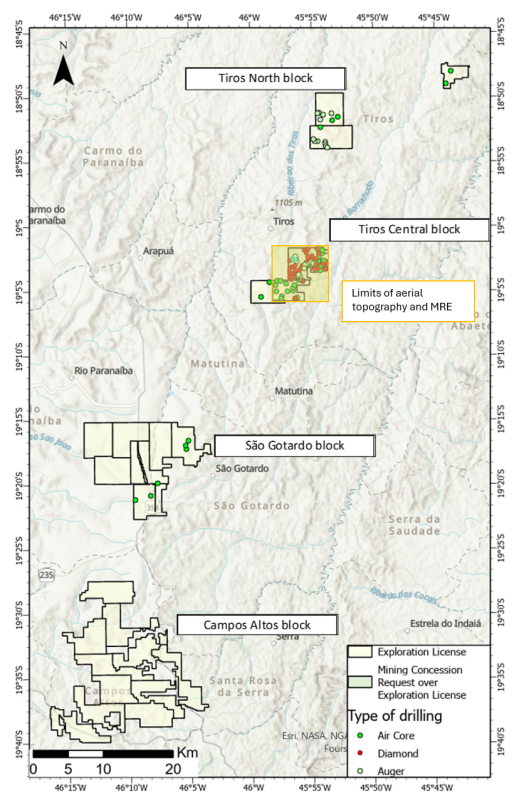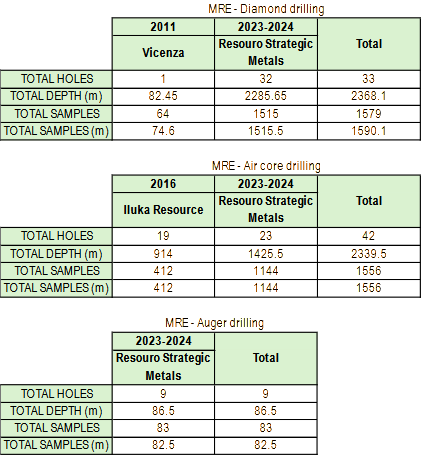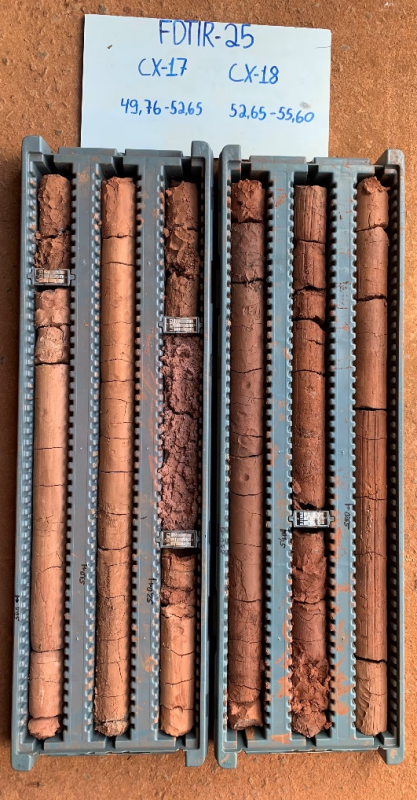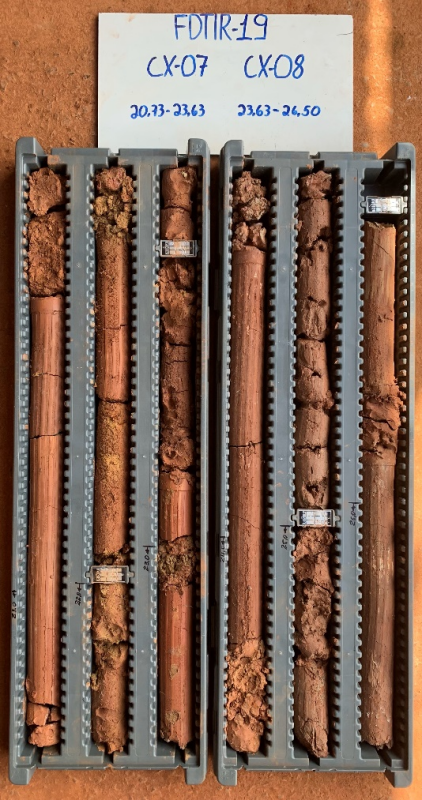Archive
Resouro Strategic Metals Metallurgy Update for the Tiros Project
 | |||||||||
 |  | ||||||||
Resouro Strategic Metals Inc. 12 August 2024 – TheNewswire - (ASX: RAU; TSX-V: RSM; FSE: 8TX; OTC: RSGOF) ("Resouro" or the "Company") is pleased to announce an update on its metallurgical studies for the Tiros Titanium and Rare Earth Elements Project in Brazil (“Tiros Project” or “Tiros” or “Project”) which marks a significant milestone in the Project’s development. The results from the metallurgical test work below indicate that Resouro, together with its partner Altilium Projects (Australia) Pty Ltd (“Altilium”), have the potential to achieve the highest rare earth extractions known across the industry to date.
Following the July 18, 2024 release of the Company’s maiden JORC Mineral Resource Estimate (“MRE”) for the Tiros Project, Resouro has completed the first steps of its metallurgical strategy with its partner, Altilium.
The aim of this metallurgical study was to achieve maximum extractions and recovery of Rare Earth and Titanium minerals, applying Altilium’s patented technology, including acid regeneration with minimal acid loss as well as zero waste.
Altilium assessed an approximately 50kg representative sample, covering five diamond drill holes of the Tiros JORC compliant resource in laboratory conditions and produced the following extraction results:
|
TEST |
TREY |
LREE |
MREE |
HREE |
|
L3 |
80.8% |
81.6% |
96.2% |
74.8% |
Table 1: Metallurgical Extraction using 50kg of representative sample.
President, CEO, Director and Founder, Chris Eager commented:
“Completion of our first stage of the Altilium extraction assessment for the Central Block of the Tiros Rare Earth project marks a pivotal moment for Resouro Strategic Metals and the industry as a whole.”
“These extraction results, combined with the maiden JORC mineral resource estimate, provide our shareholders with confidence that Tiros’ consistently thick, near surface and highly weathered clay-like material has strong potential to produce excellent results and meet the needs of the global demand for stable supply of rare earth critical minerals.”
“Our metallurgical studies will continue the next steps with our partner, Altilium, whilst reviewing options from the more conventional metallurgical study path. This work combined with our infill drilling for mine planning and feasibility and environmental purposes will seek to establish Resouro as a leading rare earth business.”
“Resouro is committed to sustainable practices and positive community engagement, ensuring that our growth contributes to the well-being of the regions in which we operate.”
“Resouro will continue to update the market on progress to completion of our Preliminary Economic Assessment”
Altilium Group Limited (“Altilium Group”), incorporated in England, is the parent company of Altilium Licensing Limited (“ALL”) and Altilium Projects (Australia) Pty Ltd).
Research and development for the Altilium Group is performed in Australia. Altilium Technology may be applied to ore, mining waste or process tailings. The first developed application of Altilium Technology was the Altilium Nickel Laterite Process™ which is designed to process nickel laterite ore. The Altilium Group has subsequently developed the following processes:
-
Altilium Bauxite Process - to extract metals from bauxite ore;
-
Altilium Red Mud Process - to re-process bauxite residue (tailings); and
-
Altilium Ti/REE Process - to extract titanium and rare earth elements from a lateritic ore.
The Altilium Group is proactively researching and developing new applications for its technology with a focus on the extraction of critical metals.
Altilium Group has marked the successful completion of its latest metallurgical testing phase, utilising the proprietary Altilium Ti/REE Process™ on a 50 kg composite sample provided by Resouro. This rigorous testing process, carried out at Core Resources Laboratories in Brisbane, involved air-drying and milling the sample to 0.5mm to analyse its chemical and mineral content. Three leach tests were conducted to understand the metal extractions, with the goal of generating a solution rich in rare earth elements (“REEs”) and a residue enriched with titanium. Notably, the third test, which incorporated a pre-treatment process, achieved the highest rare earth extractions known in the industry to date, demonstrating the effectiveness of Altilium's innovative approach.
Building on these promising results, Altilium Group is now focused on the next phase of development, which involves designing and executing a laboratory-scale test programme to establish the Altilium Ti/REE Process™ flowsheet. The company aims to optimise the process parameters to improve the grades and extraction efficiency of target metals, including titanium, silica, REEs, scandium, iron, and aluminium.
Christopher Gower, CEO of Altilium Group, said, “The recent completion of this “Sighter Test Work” marks a significant milestone for Altilium Group. By applying our proprietary Altilium Ti/REE Process™ (at Core Resources Laboratories), we have achieved unprecedented levels of rare earth extractions, reinforcing our commitment to innovation and excellence in resource processing. This accomplishment not only highlights the potential of our technology but also sets a new benchmark for the industry."
“Looking ahead, our focus is on refining and optimising the Altilium Ti/REE Process™ and our other process flowsheets to maximise the extraction efficiency for the target metals: titanium and rare earth elements in this case; and, alumina, iron, nickel, cobalt, scandium and more in the case of our other flowsheets. Our goal is to continually enhance the grades, yields and extractions to deliver an efficient and profitable flowsheet, positioning Altilium as a leader in sustainable mineral processing solutions."
The Altilium Metallurgical Test Work
The scope for the first stage Altilium test work was aimed at understanding the feasibility of applying the Altilium Ti/REE Process™ technology to Resouro’s samples mainly for the extraction of rare earth elements into solution.
The work involved a composite sample of 50kg, premixed by Resouro, air dried and milled to 100% passing 0.5mm. Chemical and mineralogical analysis was conducted on the head sample. Three optimization sighter leach tests were conducted using nitric acid (HNO3) applying the Altilium Ti/REE Process™ at Core Resources Laboratories in Brisbane to generate Pregnant Leach Solution (“PLS”) and residue. The samples were assayed for aluminium (Al), calcium (Ca), cobalt (Co), chromium (Cr), iron (Fe), gallium (Ga), magnesium (Mg), manganese (Mn), nickel (Ni), sulphur (S), scandium (Sc), silicon (Si), titanium (Ti), and rare earth elements (REEs).
The sighter leach test conditions were assessed as follows:
-
L1 test involved leaching at the standard acid concentration used in the Altilium Ti/REE Process
-
L2 test involved leaching at high concentration of acid.
-
L3 test involved a pre leach heat treatment process and leaching at the standard acid concentration used in the Altilium Ti/REE Process
In all these tests, REE metal extractions, acid consumptions and residue compositions were measured with the summary of extraction of the REE noted below.
|
TEST |
TREY |
LREE |
MREE |
HREE |
|
L1 |
69.3% |
69.3% |
72.5% |
73.8% |
|
L2 |
59.8% |
59.8% |
63.8% |
62.5% |
|
L3 |
80.8% |
81.6% |
96.2% |
74.8% |
Table 2: Metallurgical Extraction using 50kg of representative sample under the three test conditions.
Notably, the titanium dioxide (“TiO2”) contained in the sample reported between 2.5 – 4.5% in the PLS with the remaining pleasingly not reporting to the PLS indicating a strong possibility of TiO2 recovery by traditional metallurgical recovery methods from the residue.
The representative samples were taken from the Tiros central project area over four tenements which are the subject of the recent maiden JORC MRE announcement by Resouro dated July 18th, 2024.
Figure 1: Plan view of the Tiros project tenements including the central blocks highlighted and covered in the Maiden JORC MRE announcement and the subject of this metallurgical results announcement.
Following this announcement, Resouro will commence the second phase of the Altilium test work. This work includes testing the representative Resouro sample with the Altilium Ti/REE Process™ technology flowsheet. This work will also include separating the TiO2, and zircon, niobium and phosphate potential from the leach/residue by various beneficiation processes. In addition, the following tasks will be undertaken:
-
In-fill drilling to work towards delineating a potential JORC compliant reserve;
-
Further metallurgical test work programs with preferred laboratory partners to optimise REE extraction and TiO recovery under typical conditions;
-
Undertake a Scoping Study with Engineering Procurement and Construction Management (EPCM”) partner and other subject matter experts;
-
Complete a Preliminary Mining and Environmental Baseline survey and studies to submit bulk mining approvals and work towards a pilot project; and
-
Downstream studies and product testing to align the metallurgical flow sheet with potential future offtake partners.
The information in this announcement that relates to the Metallurgical Results is based on, and fairly represents, information compiled by Mr Sravan Maddipati a Competent Person and registered professional Metallurgist (MAUSIMM #323008) with experience in metallurgy, metallurgical studies and operations and experience in rare earth element extraction. Mr Maddipati is an employee of Altilium and has sufficient experience that is relevant to the style of mineralisation and type of deposit under consideration and to the activity being undertaken to qualify him as a Competent Persons as defined in the 2012 Edition of the Australasian Code for Reporting of Exploration Results, Mineral Resources and Ore Reserves.
Mr Simon Mortimer, a Competent and Qualified Person and registered professional geologist (FAIG #7795) with experience in geology, mineral exploration, geological modelling, mineral resource estimation and classification, and database management. Mr Mortimer is a consultant for Atticus Geoscience and has sufficient experience that is relevant to the style of mineralisation and type of deposit under consideration and to the activity being undertaken to qualify them as Competent Persons as defined in the 2012 Edition of the ‘Australasian Code for Reporting of Exploration Results, Mineral Resources and Ore Reserves’ and as Qualified Person under the National Instrument 43-101 Standards of Disclosure for Mineral Projects. Mr Maddipati and Mr Mortimer consent to the inclusion of this information in this announcement of the matters based on his information in the form and context in which it appears.
The information in this announcement that relates to Exploration Targets, Exploration Results and Mineral Resources is based on, and fairly represents, information compiled by Mr Luis Oviedo. Mr Oviedo is a consultant for Atticus Geoscience and has sufficient experience that is relevant to the style of mineralisation and type of deposit under consideration and to the activity being undertaken to qualify him as Competent Person as defined in the 2012 Edition of the ‘Australasian Code for Reporting of Exploration Results, Mineral Resources and Ore Reserves’. Certain information in this announcement is extracted from the ASX announcement titled "Resouro Strategic Metals Maiden JORC Resource for the Tiros Project" dated 18 July 2024 that relates to Exploration Targets, Exploration Results and Mineral Resources and is based upon information compiled by Mr Luis Oviedo. The Company confirms that it is not aware of any new information or data that materially affects the information included in the ASX announcement and, in the case of Exploration Targets, Exploration Results and Mineral Resources, that all material assumptions and technical parameters underpinning the estimates in the relevant market announcement continue to apply and have not materially changed. The Company confirms that the form and context in which Mr Oviedo's findings are presented have not materially been modified from the original market announcement. Mr Luis Oviedo consents to the inclusion of this information in this announcement of the matters based on his information in the form and context in which it appears.
This announcement has been authorized for release by the Board of Directors.
Contact Information:
|
Chris Eager, CEO +44 7388 0579809 |
Justin Clyne, Director +61 407 123 143 |
Melissa Hamilton, Media & Capital Partners, Director melissa.hamilton@mcpartners.com.au +61 417 750 274 |
Resouro is a Canadian incorporated mineral exploration and development company, listed on the ASX, TSXV, OTC and FSE, focused on the discovery and advancement of economic mineral projects in Brazil, including the Tiros project in Minas Gerais and the Novo Mundo Gold Project in Mato Grosso. The Tiros project represents 25 mineral concessions totalling 450 km2 located in the state of Minas Gerais, one of the most infrastructurally developed states of Brazil, 350 km from Belo Horizonte, the state capital. Resouro has released a Mineral Resource Estimate for the Tiros Project of 1.7 bn tonnes of Inferred, Indicated and Measured Resource as announced to the ASX on 18 July 2024 (TSXV 17 July 2024) and is based on the JORC Compliant Technical Report prepared by Mr Simon Mortimer and Mr Luis Oviedo of Atticus Geoscience, as follows:
|
DOMAIN |
CAT |
TONNES (t) |
TiO2 (%) |
TREO (ppm) |
MREO (ppm) |
|
HG (High Grade) |
Inferred |
42,000,000 |
23 |
8,700 |
2,200 |
|
Indicated |
55,700,000 |
23 |
9,030 |
2,380 |
|
|
Measured |
20,800,000 |
24 |
9,320 |
2,530 |
|
|
Sum |
120,000,000 |
23 |
9,000 |
2,400 |
|
|
MG (Medium Grade) |
Inferred |
620,000,000 |
11 |
3,500 |
950 |
|
Indicated |
704,000,000 |
11 |
3,650 |
1,020 |
|
|
Measured |
224,000,000 |
11 |
3,570 |
997 |
|
|
Sum |
1,500,000,000 |
11 |
3,500 |
930 |
|
|
Totals |
1,700,000,000 |
12 |
3,900 |
1,100 |
Note: Further details of the Company’s Maiden JORC MRE are contained within the Company’s announcement of 18 July, 2024.
This announcement contains certain "forward-looking information" within the meaning of applicable securities law. Forward-looking information is frequently characterized by words such as "plan", "expect", "project", "intend", "believe", "anticipate", "estimate" and other similar words, or statements that certain events or conditions "may" or "will" occur. Although we believe that the expectations reflected in the forward-looking information are reasonable, there can be no assurance that such expectations will prove to be correct. We cannot guarantee future results, performance or achievements. Consequently, there is no representation that the actual results achieved will be the same, in whole or in part, as those set out in the forward-looking information.
Forward-looking information is based on the opinions and estimates of management at the date the statements are made and are subject to a variety of risks and uncertainties and other factors that could cause actual events or results to differ materially from those anticipated in the forward-looking information. Some of the risks and other factors that could cause the results to differ materially from those expressed in the forward-looking information include, but are not limited to: general economic conditions in Canada and globally; industry conditions, including governmental regulation and environmental regulation; failure to obtain industry partner and other third party consents and approvals, if and when required; the need to obtain required approvals from regulatory authorities; stock market volatility; liabilities inherent in the mining industry; competition for, among other things, skilled personnel and supplies; incorrect assessments of the value of acquisitions; geological, technical, processing and transportation problems; changes in tax laws and incentive programs; failure to realize the anticipated benefits of acquisitions and dispositions; and the other factors. Readers are cautioned that this list of risk factors should not be construed as exhaustive.
The forward-looking information contained in this announcement is expressly qualified by this cautionary statement. We undertake no duty to update any of the forward-looking information to conform such information to actual results or to changes in our expectations except as otherwise required by applicable securities legislation. Readers are cautioned not to place undue reliance on forward-looking information.
Neither the ASX, TSX Venture Exchange nor its Regulation Services Provider (as that term is defined in the policies of the TSX Venture Exchange) accepts responsibility for the adequacy or accuracy of this release.
JORC Code, 2012 Edition – Table 1 Report
TIROS REE+Ti PROJECT – METALLURGY UPDATE
Section 1 Sampling Techniques and Data
(Criteria in this section apply to all succeeding sections.)
|
Criteria |
JORC Code explanation |
Commentary |
|
|
|
|
|
|
|
Drilling techniques |
|
|
|
Drill sample recovery |
|
|
|
|
|
|
|
|
|
Logging |
|
|
|
|
|
|
|
|
|
Sub-sampling techniques and sample preparation |
|
|
|
Quality of assay data and laboratory tests |
|
|
|
|
|
|
|
|
|
Verification of sampling and assaying |
|
|
|
|
|
|
|
|
|
|
|
|
Location of data points |
|
|
|
|
|
|
|
|
|
Data spacing and distribution |
|
|
|
|
|
|
|
|
|
Orientation of data in relation to geological structure |
|
|
|
|
|
|
Sample security |
|
|
|
Audits or reviews |
|
|
Section 2 Reporting of Exploration Results
|
Criteria |
JORC Code explanation |
Commentary |
||||||||||||||||||||||||||||||||||||||||||||||||
|
Mineral tenement and land tenure status |
|
|
||||||||||||||||||||||||||||||||||||||||||||||||
|
|
|||||||||||||||||||||||||||||||||||||||||||||||||
|
Exploration done by other parties |
|
|
||||||||||||||||||||||||||||||||||||||||||||||||
|
Geology |
|
The Capacete Formation is the result of the sedimentation of the erosion product of the rocks of the Patos Formation, also belonging to the Mata da Corda Group. The Patos Formation represents a voluminous set of Upper Cretaceous kamafugite pyroclastic flows and deposits, hosted in the Brasília Belt, southwest of the São Francisco Craton. |
||||||||||||||||||||||||||||||||||||||||||||||||
|
Drill hole Information |
|
The sample used for this metallurgical test was made by 40 representative samples selected randomly from the mineralized interval intercepted in the drill holes listed below. TiO2 % and TREO ppm grades calculated from the weighted average grades of the individual samples is given in the table below:
|
||||||||||||||||||||||||||||||||||||||||||||||||
|
Data aggregation methods |
|
|
||||||||||||||||||||||||||||||||||||||||||||||||
|
TREY: HREE + LREE HREE: ([Dyppm]) + ([Erppm] ) + ([Euppm]) + ([Gdppm]) + ([Hoppm]) + ([Luppm]) + ([Tbppm]) + ([Tmppm] ) + ([Ybppm]) + ([Yppm]) LREE: ([Ceppm]) + ([Lappm] + ([Ndppm]) + ([Prppm]) + ([Smppm]) MREE: ([Prppm]) + ([Ndppm]) + ([Tbppm]) + ([Dyppm]) |
|||||||||||||||||||||||||||||||||||||||||||||||||
|
Relationship between mineralization widths and intercept lengths |
|
|
||||||||||||||||||||||||||||||||||||||||||||||||
|
Diagrams |
|
|
||||||||||||||||||||||||||||||||||||||||||||||||
|
Balanced reporting |
|
|
||||||||||||||||||||||||||||||||||||||||||||||||
|
Other substantive exploration data |
|
|
||||||||||||||||||||||||||||||||||||||||||||||||
|
Further work |
|
|




